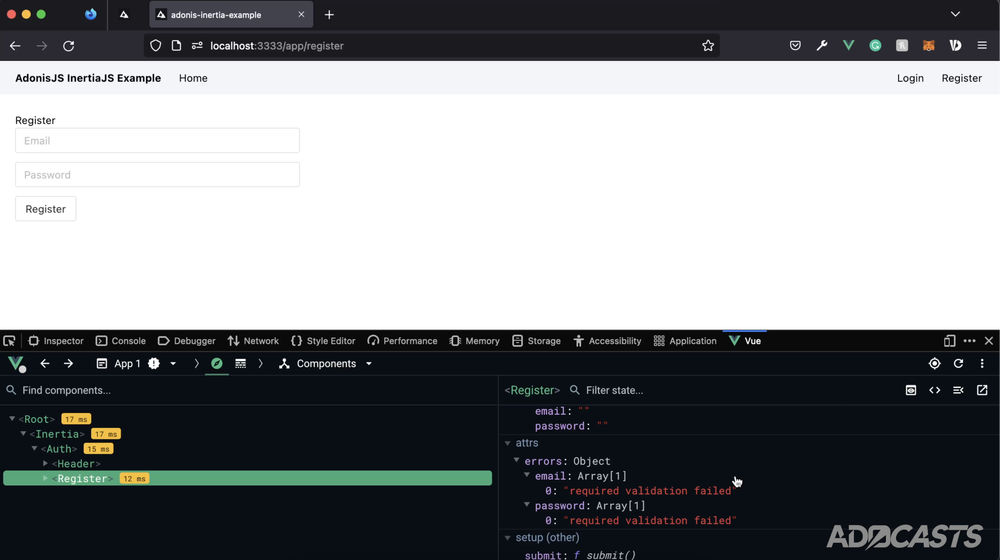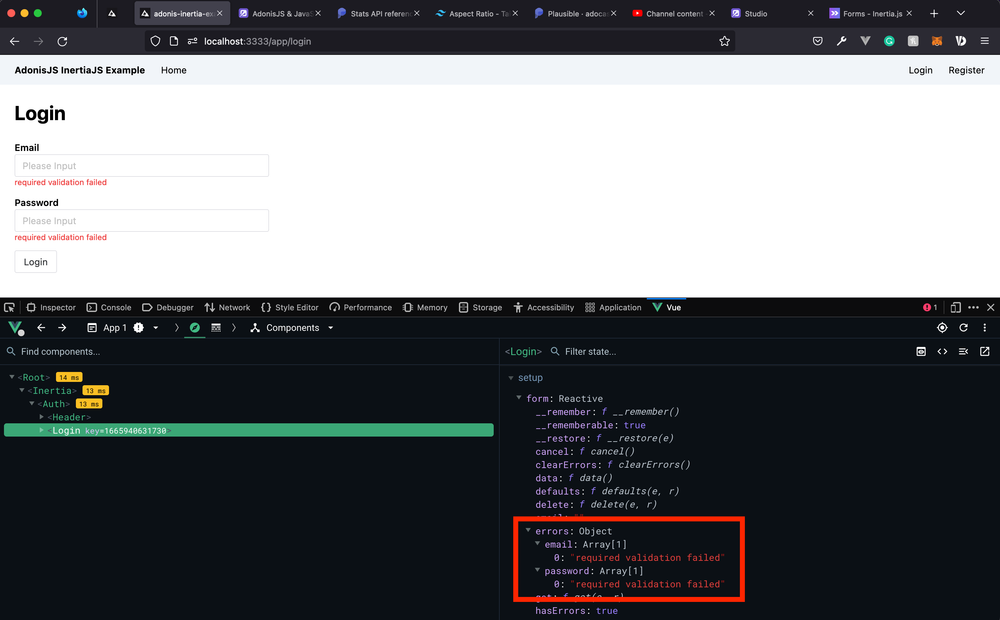In prior lessons, we created a Register and Login page. Both of these pages contain a form that, when submitted, sends a POST request off to a route. We aren't currently doing anything with these routes, beyond console logging the body to confirm it's received.
Creating & Applying Validation
In order to learn about InertiaJS' form validation error handling, we'll need to first add validation to both of these routes in our AdonisJS application. Since both register and login will use the same fields we can make a generic validator called AuthValidator.
node ace make:validator AuthCopied!
Within our AuthValidator, we'll define rules for both our email and password fields. I'll omit the comment blocks for brevity's sake.
import { schema, CustomMessages } from '@ioc:Adonis/Core/Validator' import { schema, rules, CustomMessages } from '@ioc:Adonis/Core/Validator' import type { HttpContextContract } from '@ioc:Adonis/Core/HttpContext' export default class AuthValidator { constructor(protected ctx: HttpContextContract) {} public schema = schema.create({ email: schema.string({ trim: true }, [rules.email()]), password: schema.string({}, [rules.minLength(8)]) }) public messages: CustomMessages = {} }Copied!
- app
- Validators
- AuthValidator.ts
First, we'll want to include rules within our import from @ioc:Adonis/Core/Validator. Then, we'll define our email and password schema properties, setting them both to strings. Our email will be trimmed and verified it's an email value. Our password will require a minimum length of eight characters.
Applying Our Validator
Now that we have a validator created, let's go ahead and apply it to our login and register POST route handlers.
Route.post('/login', async ({ request, response }) => { console.log({ loginBody: request.body() }) const data = await request.validate(AuthValidator) console.log({ data }) return response.redirect().toRoute('app.index') }).as('login.store') Route.post('/register', async ({ request, response }) => { console.log({ registerBody: request.body() }) const data = await request.validate(AuthValidator) console.log({ data }) return response.redirect().toRoute('app.index') }).as('register.store')Copied!
- start
- routes.ts
How InertiaJS Handles Validation
Okay, now we have validation on our login and register forms. Let's next take a look, using the VueJS Devtools, at what happens with InertiaJS when we submit our form with invalid data.

As you can see, InertiaJS automatically plops our validation errors onto our VueJS component. Now, it's listed within the attributes (attrs) at the moment, but that's only because we haven't registered it as a prop. So, let's go ahead and do that next.
// resources/js/Pages/Register.vue
// resources/js/Pages/Login.vue
export default {
layout: AuthLayout,
props: {
errors: {
type: Object,
default: () => ({})
}
},
// ...
}Note, you'll want to do this for both your register and login pages. All we're doing here is registering the prop errors as an object and defining its default value as an empty object. Setting the default here simply saves us from having to check for its existence, so that we only need to worry about individual properties on the object.
How Are Errors Made Available?
At this point, you may be wondering exactly how errors is made available as a prop on both of these pages. This is actually something set up by the eidellev/inertiajs-adonisjs adapter package. If you look within your start/inertia.ts file, you'll see the below.
import Inertia from '@ioc:EidelLev/Inertia'; Inertia.share({ errors: (ctx) => { return ctx.session.flashMessages.get('errors'); }, }).version(() => Inertia.manifestFile('public/assets/manifest.json'));Copied!
This file allows us to share values form our AdonisJS server to our Vue 3 client application. As you can see this is pre-populated with errors, whose value is the value of our errors flash messaging, aka our validation messages. It's worth noting you can add other properties you need to share with your Vue application here as well. Okay, back to our validation!
Errors Are Also On the Form Helper
Additionally, if you make use of the useForm hook like we are on our Login page you can grab the errors object directly off the form within your data as well, as you can see below.

Special thanks to Pierre-Marc Marin for reminding me about the errors existing on the useForm data object!
Displaying Validation Error Messages
Now that we have our errors defined on our pages, we're good to go ahead and apply them within our templates. I'm also going to wrap each input in a div with a margin to appear more like a form group.
<template> <!-- resources/js/Pages/Register.vue --> <div> <h1>Register</h1> <form @submit.prevent="submit" class="max-w-sm"> <n-input type="email" v-model:value="form.email" placeholder="Email" class="mb-3" /> <div class="mb-3"> <n-input type="email" v-model:value="form.email" placeholder="Email" /> <div v-if="errors.email" class="text-xs text-red-500 mt-1"> {{ errors.email.join(', ') }} </div> </div> <n-input type="password" v-model:value="form.password" placeholder="Password" class="mb-3" /> <div class="mb-3"> <n-input type="password" v-model:value="form.password" placeholder="Password" /> <div v-if="errors.password" class="text-xs text-red-500 mt-1"> {{ errors.password.join(', ') }} </div> </div> <n-button attr-type="submit"> Register </n-button> </form> </div> </template>Copied!
For our actual error display, since we're defaulting errors to an empty object, all we need to do is check to see whether the email and password properties exist on the object (ie: an error occurred). If an error did occur, as we saw in the earlier screenshot, the properties contain an array of error messages, structured like the one below.
const errors = { email: ['required validation failed'], password: ['required validation failed'] }Copied!
Hence, when it comes to displaying the actual error within our template, we can join whatever errors are on the properties as a comma-delimited list by joining the array, like the below.
{{ errors.email.join(', ') }}Copied!
Creating A Form Input Component
Now, it's likely that we'll want to re-use the form group block of code we just created above all over our application, so let's move it off into a component.
<template> <!-- resources/js/components/FormInput.vue --> <div class="mb-3"> <label> <span v-if="label" class="block font-semibold">{{ label }}</span> <n-input :type="type" v-model:value="internalValue" :placeholder="placeholder" /> </label> <div v-if="Array.isArray(errors)" class="text-xs text-red-500"> {{ errors.join(', ') }} </div> </div> </template> <script setup> import { computed } from 'vue' const props = defineProps({ type: { type: String, default: 'text' }, label: String, placeholder: String, modelValue: String, errors: Array }) const emit = defineEmits(['update:modelValue']) const internalValue = computed({ get() { return props.modelValue }, set(value) { emit('update:modelValue', value) } }) </script>Copied!
Our input will accept a type (defaulting to text), label, placeholder, modelValue, and the field's errors as its props. Then, we'll use a computed field to get and set an internalValue. Additionally, note that our errors here will be an array since they'll be specific to the individual field. So, we'll want to use Array.isArray(errors) to check and see if the field has any errors.
Applying Our Form Input Component
Lastly, let's go ahead and apply our new component on both our register and login forms.
<template> <!-- resources/js/Pages/Register.vue --> <div> <h1 class="text-3xl font-bold mb-6">Register</h1> <form @submit.prevent="submit" class="max-w-sm"> <div class="mb-3"> <n-input type="email" v-model:value="form.email" placeholder="Email" /> <div v-if="errors.email" class="text-xs text-red-500 mt-1"> {{ errors.email.join(', ') }} </div> </div> <div class="mb-3"> <n-input type="password" v-model:value="form.password" placeholder="Password" /> <div v-if="errors.password" class="text-xs text-red-500 mt-1"> {{ errors.password.join(', ') }} </div> </div> <form-input label="Email" type="email" v-model="form.email" :errors="errors.email" /> <form-input label="Password" type="password" v-model="form.password" :errors="errors.password" /> <n-button attr-type="submit"> Register </n-button> </form> </div> </template> <script> import AuthLayout from '@/Layouts/Auth.vue' import FormInput from '@/components/FormInput.vue' import { reactive } from 'vue' import { Inertia } from '@inertiajs/inertia' export default { layout: AuthLayout, props: { errors: { type: Object, default: () => ({}) } }, components: { FormInput }, // ... } </script>Copied!
And, the same for our login page.
<template> <!-- resources/js/Pages/Login.vue --> <div> <h1 class="text-3xl font-bold mb-6">Login</h1> <form @submit.prevent="form.post('/app/login')" class="max-w-sm"> <n-input type="email" v-model:value="form.email" placeholder="Email" class="mb-3" /> <n-input type="password" v-model:value="form.password" placeholder="Password" class="mb-3" /> <form-input label="Email" type="email" v-model="form.email" :errors="errors.email" /> <form-input label="Password" type="password" v-model="form.password" :errors="errors.password" /> <n-button attr-type="submit"> Login </n-button> </form> </div> </template> <script> import AuthLayout from '@/Layouts/Auth.vue' import FormInput from '@/components/FormInput.vue' import { useForm } from '@inertiajs/inertia-vue3' export default { layout: AuthLayout, props: { errors: { type: Object, default: () => ({}) } }, components: { FormInput }, // ... } </script>Copied!
Next Up
Now that we have a decent understanding of how to approach form validation error handling within InertiaJS, we can take a slight pivot. In the next lesson, we'll learn how to handle flash messaging within our Adonis Inertia application.
